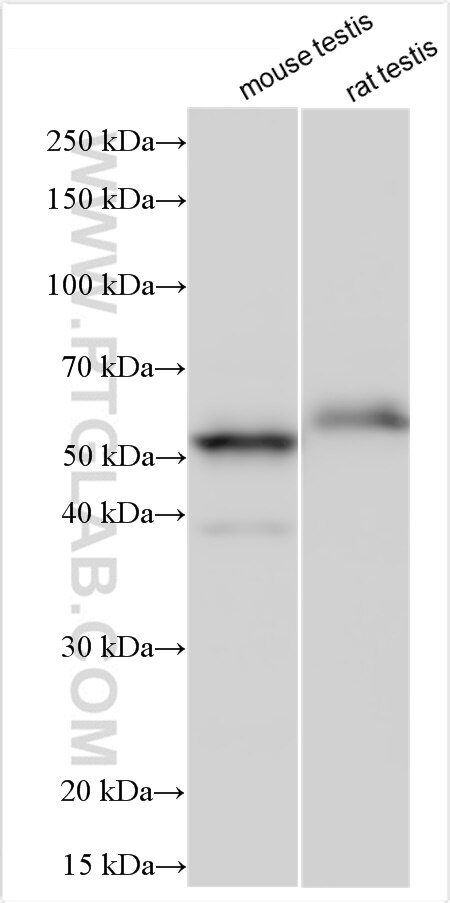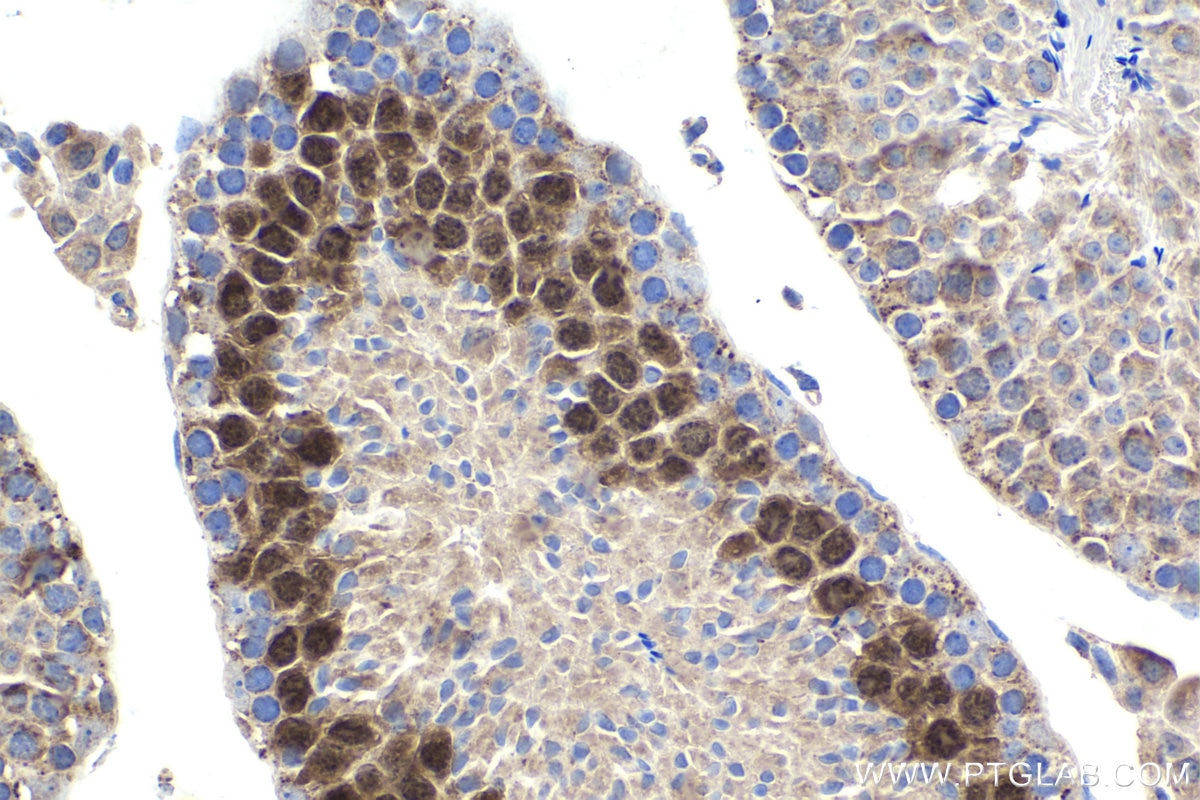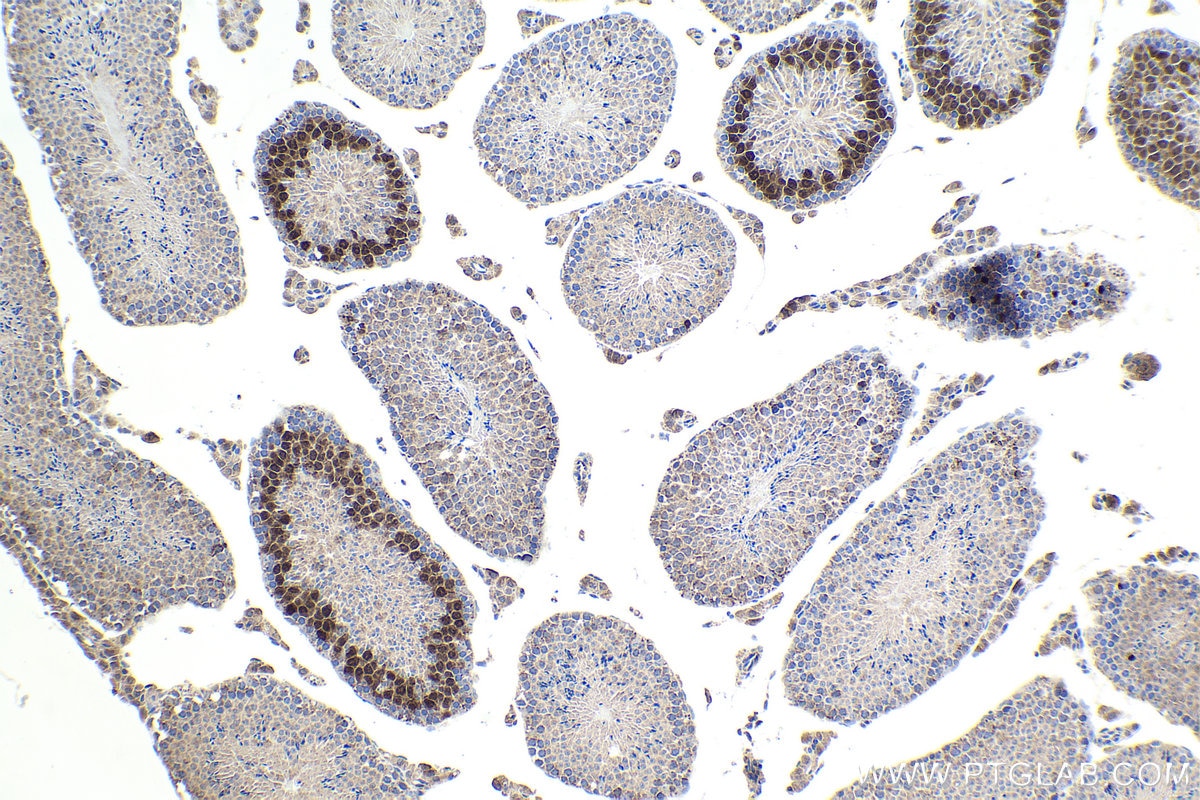Anticorps Polyclonal de lapin anti-Cyclin A1
Cyclin A1 Polyclonal Antibody for WB, IHC, ELISA
Hôte / Isotype
Lapin / IgG
Réactivité testée
Humain, rat, souris
Applications
WB, IHC, ELISA
Conjugaison
Non conjugué
N° de cat : 13295-1-AP
Synonymes
Galerie de données de validation
Applications testées
| Résultats positifs en WB | tissu testiculaire de souris, tissu testiculaire de rat |
| Résultats positifs en IHC | tissu testiculaire de souris, il est suggéré de démasquer l'antigène avec un tampon de TE buffer pH 9.0; (*) À défaut, 'le démasquage de l'antigène peut être 'effectué avec un tampon citrate pH 6,0. |
Dilution recommandée
| Application | Dilution |
|---|---|
| Western Blot (WB) | WB : 1:500-1:1000 |
| Immunohistochimie (IHC) | IHC : 1:500-1:2000 |
| It is recommended that this reagent should be titrated in each testing system to obtain optimal results. | |
| Sample-dependent, check data in validation data gallery | |
Applications publiées
| WB | See 32 publications below |
Informations sur le produit
13295-1-AP cible Cyclin A1 dans les applications de WB, IHC, ELISA et montre une réactivité avec des échantillons Humain, rat, souris
| Réactivité | Humain, rat, souris |
| Réactivité citée | rat, Humain, souris |
| Hôte / Isotype | Lapin / IgG |
| Clonalité | Polyclonal |
| Type | Anticorps |
| Immunogène | Cyclin A1 Protéine recombinante Ag4005 |
| Nom complet | cyclin A1 |
| Masse moléculaire calculée | 464 aa, 52 kDa |
| Poids moléculaire observé | 52 kDa |
| Numéro d’acquisition GenBank | BC036346 |
| Symbole du gène | Cyclin A1 |
| Identification du gène (NCBI) | 8900 |
| Conjugaison | Non conjugué |
| Forme | Liquide |
| Méthode de purification | Purification par affinité contre l'antigène |
| Tampon de stockage | PBS with 0.02% sodium azide and 50% glycerol |
| Conditions de stockage | Stocker à -20°C. Stable pendant un an après l'expédition. L'aliquotage n'est pas nécessaire pour le stockage à -20oC Les 20ul contiennent 0,1% de BSA. |
Informations générales
CCNA1 belongs to the highly conserved cyclin family, whose members are characterized by a dramatic periodicity in protein abundance through the cell cycle. CCNA1 binds both CDK2 and CDC2 kinases, which give two distinct kinase activities, one appearing in S phase, the other in G2, and thus regulate separate functions in cell cycle. CCNA1 was found to bind to important cell cycle regulators, such as Rb family proteins, transcription factor E2F-1, and the p21 family proteins. In general, the expression of CCNA1 is tissue-specific and high CCNA1 expression is limited to testis; besides, lower levels of CCNA1 expression are also observed in other human cell lines and in healthy brain. Currently, CCNA1 expression has been illustrated to be downregulated in various tumors, including head and neck squamous-cell cancer (HNSCC) and nasopharyngeal carcinoma; and the promoter of the CCNA1 gene is found to be frequently methylated in colon cancer and HNSCC.
Protocole
| Product Specific Protocols | |
|---|---|
| WB protocol for Cyclin A1 antibody 13295-1-AP | Download protocol |
| IHC protocol for Cyclin A1 antibody 13295-1-AP | Download protocol |
| Standard Protocols | |
|---|---|
| Click here to view our Standard Protocols |
Publications
| Species | Application | Title |
|---|---|---|
Curr Biol RPL10L Is Required for Male Meiotic Division by Compensating for RPL10 during Meiotic Sex Chromosome Inactivation in Mice. | ||
Biomaterials Biocompatible PEGylated Gold nanorods function As cytokinesis inhibitors to suppress angiogenesis. | ||
J Cell Mol Med NDUFA4L2 in smooth muscle promotes vascular remodeling in hypoxic pulmonary arterial hypertension. | ||
Mol Cancer MicroRNA-505 functions as a tumor suppressor in endometrial cancer by targeting TGF-α. |




